What does the marketing research and insight industry look like in 2021?
One of the main goals of Quirk’s annual Q Report is to better understand the client-side researcher and see what’s on their minds. Since the beginning of the pandemic, the pace of change has begun to increase, prompting us to focus on a few topics – flexibility, diversity and shifts in employment – that hit the global spotlight in 2020 to see how they have impacted marketing research and insights professionals.
As we’ve done in past reports, we’re (mostly) letting the data speak for itself, highlighting interesting tidbits and respondent comments throughout. You will also find a few data points from years past to show how far we’ve come and highlight what has – and hasn’t – changed in the last few years.
The 2021 edition of Quirk’s annual survey received responses from a total of 816 full-time (defined as 35+ hours per week) client-side insights professionals. The survey has more to offer than we can include in this report. If you are interested in seeing a breakdown of compensation for all job titles, including crosstabs by age, gender, location, industry and more, visit www.quirks.com/tools/salary-survey.
So what does the research industry look like in 2021?
Importance of flexibility
With work from home trending, we asked respondents, “How important is it to you that your organization allows the flexibility to work remotely either partially or fully?” A whopping 78% said this is extremely important or very important. Interestingly, 54% of women said it was extremely important as compared to only 37% of men.
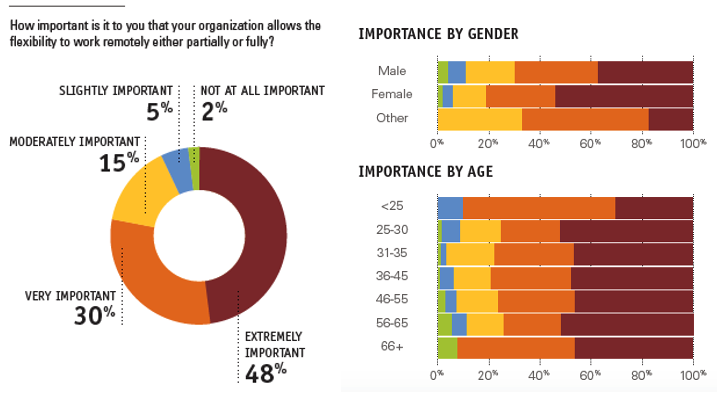
Diversity
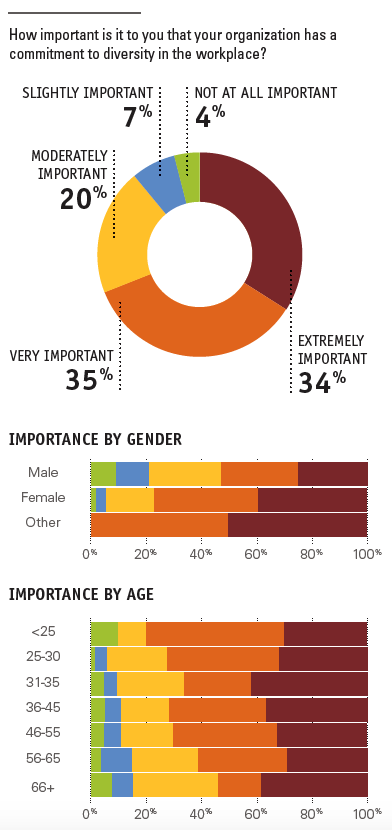 In 2020, like many industries around the world, research and insights put a heavy focus on diversity. When asked, “How important is it to you that your organization has a commitment to diversity in the workplace?” a combined 69% of respondents said extremely important or very important.
In 2020, like many industries around the world, research and insights put a heavy focus on diversity. When asked, “How important is it to you that your organization has a commitment to diversity in the workplace?” a combined 69% of respondents said extremely important or very important.
When looking through this year’s verbatims, many respondents noted the need for more diversity and inclusion efforts, both in terms of the research being conducted and the profession:
More diversity and inclusion-based research. Using more vendors that focus on diversity markets or are diversity-founded.
After investing year after year in digital analytics, our new CMO has made an investment in an additional analyst on the market research side. We look forward to hiring this new person in the next year. This person will focus on our audience of the future (younger and more racially and ethnically diverse).
The profession has to be more encompassing of a diverse workforce.
2020 also saw the launch of several new diversity-focused industry organizations: Colour of Research (https://www.colourofresearch.org), a global community driven to bring about more diversity in the research industry; Insights in Color (https://www.insightsincolor.com), a community for multicultural market research and insights professionals; and Out in Research, a group championing LGBTQ+ diversity within the industry. WIRe in Color (https://www.womeninresearch.org/wire-in-color), which launched in 2018, is another industry group focused on racial and cultural diversity and equity.
Changes in employment
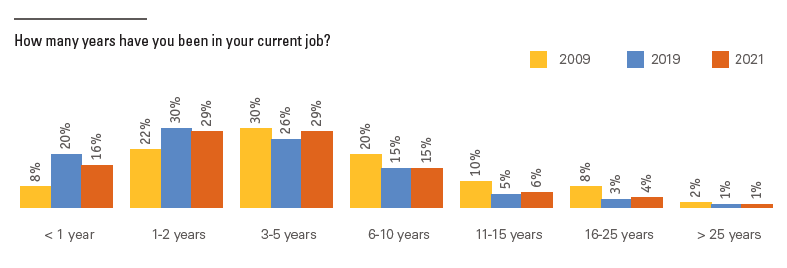 Back in 2010, a combined 60% of respondents said it was very unlikely, unlikely or somewhat unlikely that their companies would hire additional employees. In 2019, months before the COVID-19 pandemic, that number sat at 48%. This year, it fell to 43%.
Back in 2010, a combined 60% of respondents said it was very unlikely, unlikely or somewhat unlikely that their companies would hire additional employees. In 2019, months before the COVID-19 pandemic, that number sat at 48%. This year, it fell to 43%.
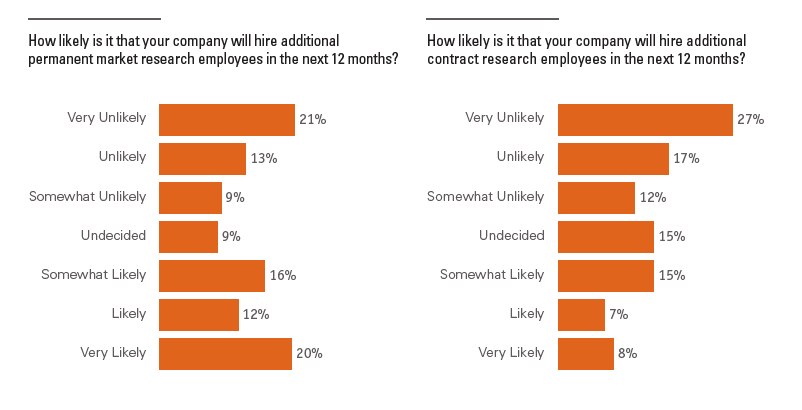
But, are researchers looking for new jobs? According to our survey, only 8% said they were very likely to seek employment at a different company this year. This may be related to the fact that the percentage of researchers who are new to their positions is up, with 16% reporting they have been in their current job for less than a year, as compared to 13% in 2019 and 8% in 2009.
Several respondents shared their experiences regarding layoffs, employment challenges and victories:
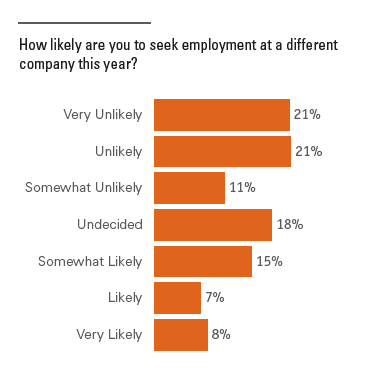 I was only laid off two months and was very busy interviewing the whole time, and was on the final round with several companies when I accepted an offer.
I was only laid off two months and was very busy interviewing the whole time, and was on the final round with several companies when I accepted an offer.
I’ve been laid off twice from organizations that were obviously not committed and convinced of the value received, however I’m currently with an organization that highly values insights and leadership expects them in all strategic and tactical plans. But if I could do my career over again I would choose another profession because those layoffs were huge setbacks to my career and life that I’m still paying for.
Wouldn’t be surprised if they are trying to do away with research. None of our positions are ever backfilled when someone leaves. Everyone is terribly overwhelmed with work and unsupportive leaders.
I feel underpaid on the client side and have considered returning to the vendor side.
I’m in a position where we don’t have enough business to hire a new person but I can’t take on much more business without another person. It is a Catch-22.
I was hired six months ago to revamp the MR function at my company. There is great enthusiasm for more and better research, yet also a fair amount of reluctance to let go of the way things have been done for decades (without consistent professional leadership in the MR function). I’m content and pleased with the level of enthusiasm for better research, though there are still challenges ahead.
I love [my job]! I have to motivate myself but the idea of gleaning some type of learning from talking to a customer, reading over survey results, etc., makes me happy and keeps me going.
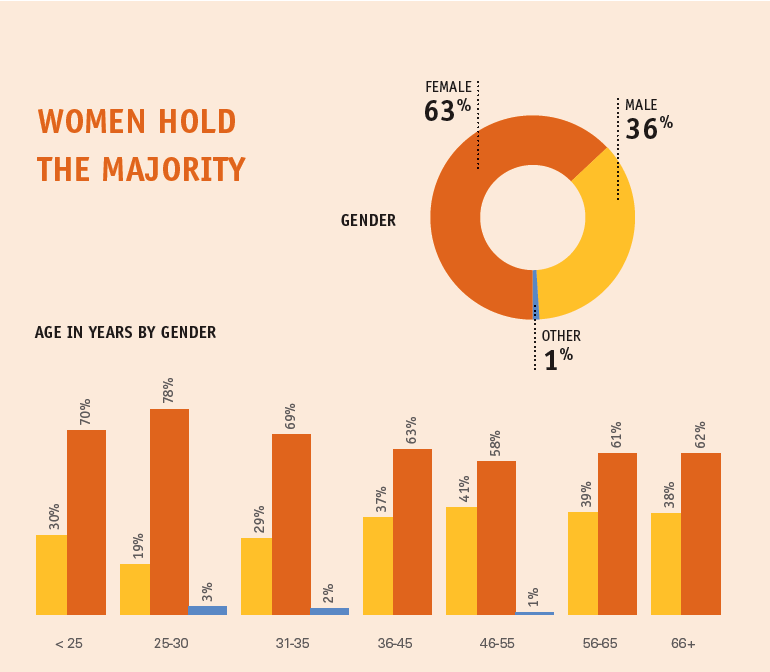
Methodology
The 2021 Q Report work life and salary and compensation study of end-client/corporate researchers is based on data gathered from an invite-only online survey sent to pre-qualified marketing research subscribers of Quirk’s. The survey was fielded from June 10 to July 16, 2021. In total we received 1,951 usable qualified responses of which 816 were from end-client researchers and used for this end-client report. An interval (margin of error) of 2.16 at the 95% confidence level was achieved for the entire study. (Not all respondents answered all questions.)
